组织结构论文(英文版)organizational structure essay.
2024年宁德时代的组织结构和部门定位英文版
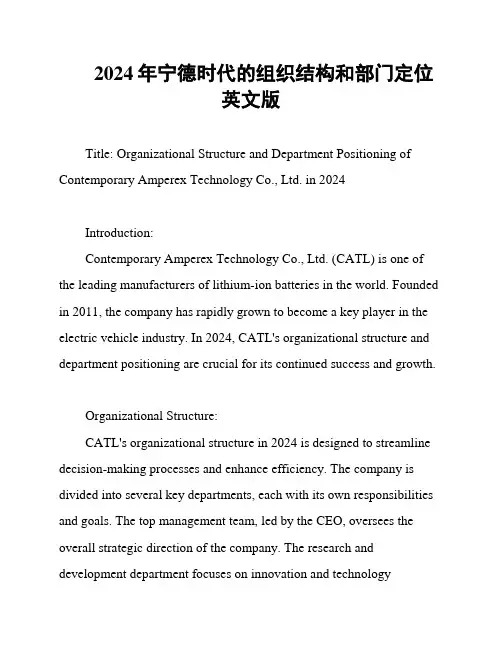
2024年宁德时代的组织结构和部门定位英文版Title: Organizational Structure and Department Positioning of Contemporary Amperex Technology Co., Ltd. in 2024Introduction:Contemporary Amperex Technology Co., Ltd. (CATL) is one of the leading manufacturers of lithium-ion batteries in the world. Founded in 2011, the company has rapidly grown to become a key player in the electric vehicle industry. In 2024, CATL's organizational structure and department positioning are crucial for its continued success and growth.Organizational Structure:CATL's organizational structure in 2024 is designed to streamline decision-making processes and enhance efficiency. The company is divided into several key departments, each with its own responsibilities and goals. The top management team, led by the CEO, oversees the overall strategic direction of the company. The research and development department focuses on innovation and technologyadvancement, while the production department is responsible for manufacturing high-quality batteries. The sales and marketing department is in charge of promoting CATL's products and expanding its market share. The finance and human resources departments support the company's operations by managing financial resources and human capital effectively.Department Positioning:In 2024, each department at CATL has a clear positioning within the company's overall structure. The research and development department plays a crucial role in driving innovation and developing cutting-edge battery technologies. The production department ensures that CATL's batteries meet the highest quality standards and are produced efficiently. The sales and marketing department is responsible for identifying new business opportunities, building partnerships, and promoting CATL's brand globally. The finance department manages the company's financial resources, while the human resources department focuses on recruiting and retaining top talent.Conclusion:CATL's organizational structure and department positioning in 2024 are essential for the company's continued success in the competitive battery industry. By focusing on innovation, quality, sales, finance, and human resources, CATL is well-positioned to achieve its goals and maintain its leadership position in the market.。
关于公司结构的英语作文
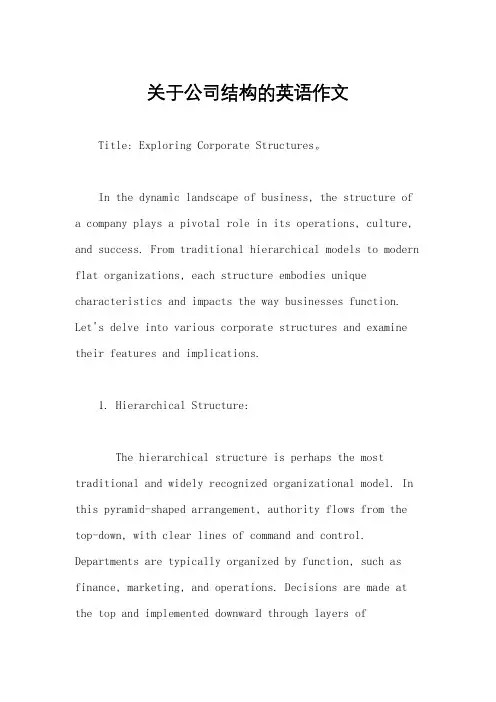
关于公司结构的英语作文Title: Exploring Corporate Structures。
In the dynamic landscape of business, the structure of a company plays a pivotal role in its operations, culture, and success. From traditional hierarchical models to modern flat organizations, each structure embodies unique characteristics and impacts the way businesses function. Let's delve into various corporate structures and examine their features and implications.1. Hierarchical Structure:The hierarchical structure is perhaps the most traditional and widely recognized organizational model. In this pyramid-shaped arrangement, authority flows from the top-down, with clear lines of command and control. Departments are typically organized by function, such as finance, marketing, and operations. Decisions are made at the top and implemented downward through layers ofmanagement.Advantages:Clear chain of command facilitates efficient decision-making.Specialization within departments promotes expertise and focus.Defined roles and responsibilities provide clarity for employees.Disadvantages:Can lead to bureaucracy and slow decision-making processes.Limited communication between different levels of the hierarchy.Innovation may be stifled due to rigid structures.2. Flat Structure:Contrary to the hierarchical model, the flat structure minimizes levels of management and promotes a more egalitarian approach. There are fewer layers between the top executives and front-line employees, fostering a sense of empowerment and autonomy. Teams are often organized around projects or tasks rather than traditional departments.Advantages:Enhanced communication and collaboration acrossall levels.Quick decision-making as there are fewer bureaucratic hurdles.Encourages innovation and creativity by empowering employees.Disadvantages:Lack of clear career progression paths may demotivate some employees.Requires strong self-discipline and accountability from all members.Challenges in maintaining consistency and coordination across diverse teams.3. Matrix Structure:The matrix structure blends elements of both hierarchical and flat organizations. Employees report to both functional managers (e.g., finance, marketing) and project managers simultaneously. This dual reporting system allows for flexibility and specialization while also fostering cross-functional collaboration.Advantages:Maximizes resource utilization by pooling expertise across functions.Encourages innovation through diverse perspectives and skillsets.Provides opportunities for skill development and career growth.Disadvantages:Can lead to conflicts over priorities and responsibilities.Complex reporting relationships may cause confusion and inefficiency.Requires strong communication and conflict resolution skills to manage effectively.4. Network Structure:In the network structure, organizations outsource most functions to external partners, relying on a networkof contractors, suppliers, and other stakeholders to carry out operations. This flexible model allows companies to adapt quickly to changing market conditions and focus on their core competencies.Advantages:Enables rapid scalability and resource flexibility.Access to specialized expertise without the needfor in-house resources.Reduces overhead costs associated with maintaining large internal teams.Disadvantages:Limited control over external partners may lead to quality and reliability issues.Coordination and communication challenges across decentralized networks.Dependency on external entities can introduce risks to the business.In conclusion, the choice of corporate structure significantly influences how a company operates, communicates, and innovates. While each model has its own set of advantages and disadvantages, there is no one-size-fits-all solution. Successful organizations carefully evaluate their needs, culture, and strategic objectives to determine the most suitable structure that aligns with their vision and fosters sustainable growth.。
组织结构论文(英文版)organizational structure essay.
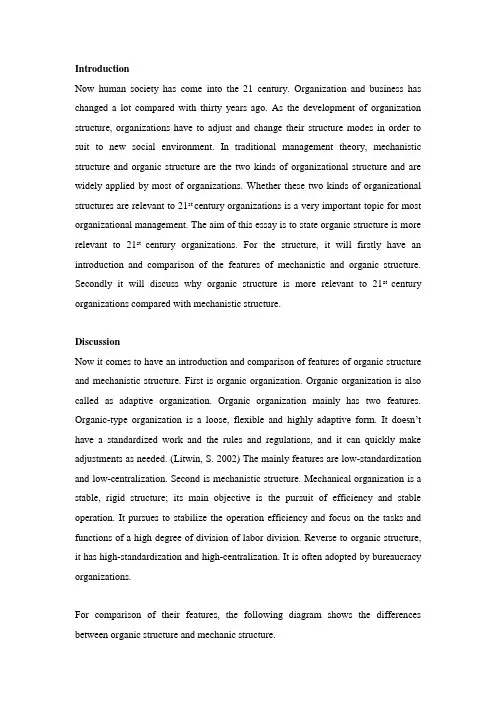
IntroductionNow human society has come into the 21 century. Organization and business has changed a lot compared with thirty years ago. As the development of organization structure, organizations have to adjust and change their structure modes in order to suit to new social environment. In traditional management theory, mechanistic structure and organic structure are the two kinds of organizational structure and are widely applied by most of organizations. Whether these two kinds of organizational structures are relevant to 21st century organizations is a very important topic for most organizational management. The aim of this essay is to state organic structure is more relevant to 21st century organizations. For the structure, it will firstly have an introduction and comparison of the features of mechanistic and organic structure. Secondly it will discuss why organic structure is more relevant to 21st century organizations compared with mechanistic structure.DiscussionNow it comes to have an introduction and comparison of features of organic structure and mechanistic structure. First is organic organization. Organic organization is also called as adaptive organization. Organic organization mainly has two features. Organic-type organization is a loose, flexible and hig hly adaptive form. It doesn’t have a standardized work and the rules and regulations, and it can quickly make adjustments as needed. (Litwin, S. 2002) The mainly features are low-standardization and low-centralization. Second is mechanistic structure. Mechanical organization is a stable, rigid structure; its main objective is the pursuit of efficiency and stable operation. It pursues to stabilize the operation efficiency and focus on the tasks and functions of a high degree of division of labor division. Reverse to organic structure, it has high-standardization and high-centralization. It is often adopted by bureaucracy organizations.For comparison of their features, the following diagram shows the differences between organic structure and mechanic structure.(Westbrook, J 2004)According to the above comparison of the features between mechanic structures and organic, now it aims to discuss why organic structure is more relevant to 21st organizations. This should base on the features of the 21st organizations’ developingtrend. This mainly includes three aspects.First, the 21st century situation needs organizations to have quick respond. As information technology develops better and better, business and operations become more and more complex, and there are often many uncertainties and emergency events. The IT time needs organizations can make quick respond for changes. For an organic structure organization, it has the features of low-standardization and low- centralization. When facing with emergency or unexpected changes, staffs can have their own decision—making right to deal with affairs timely. It is very important to avoid losses and mistakes in task. Also staffs can communicate with others to get the ideas for dealing with affairs. (Anders, C 2008) While for a mechanistic structure organization, when staffs face with changes or emergency, they don’t have decision making right. They must report it to their supervisors, and supervisors need to report to senior leaders. After the seniors make decision make give instruction to supervisors, supervisors can give instruction to staffs. The complex process will delay a lot of time and largely affect task efficiency. (Klarbring, A 2009) The organization cannot make quick respond to affairs and will lead to loss and troubles.Second, in 21st century, knowledge sharing and member communication become more and more important. As knowledge and experience improves very fast in 21st century, a single person or several persons cannot have the ability to acquire all necessary knowledge and technology in job process. And technology is the key factor for competitiveness. So the communication and knowledge sharing in organizations play very important roles for 21st century organizations. For an organic organization, staffs can well communicate with others, including supervisors and other staffs to become more familiar with necessary knowledge, which is very helpful for finishing tasks. Also it can improve the professional quality of all staffs. (Harrison, M and Janice, M. 2004) While for a mechanistic structure, the communication mode is vertical, and staffs can only receive orders from their supervisors. However, the supervisors all not all—round, if they don’t have enough knowledge acquirement, it will lead to troublesin task.Third, for 21st organizations, continuous creativity is the key factor to keep competitiveness. With economic globalization and information technology, user needs increasingly diversified and personalized, product technology content and research costs increased product and life cycles shorten. For this condition, organizations must keep creativity to keep their competitiveness in market economy and knowledge economy time. For an organic structure organization, its value is efficiency and performance. It emphasizes personal contribution and performance, and it encourages communications among all people. This supplies good environment for creativity. Also its low-centralization helps staffs to perform innovation tasks without constraint. (Kenny, G 2006) Staffs can try their best to make develop creativity and make performance. However, for a mechanistic structure organization, the value is to obey rules and supervisors. Staffs don’t have the motivation and right to share knowledge and make creativity. Only the senior leaders can make creativity and make decision. This largely hinders creativity in organizations.ConclusionIn conclusion, for 21st organizations, they need to have quick respond, good knowledge sharing and member communication and continuous creativity to keep their competitiveness and according to structure features, organic structure is more relevant to 21st organizations. After the above discussion, it is found that the low- standardization and low-centralization and the value of staffs’ performance are helpful for an organic organization to make quick respond to emergency, form a good environment for knowledge sharing and communication and encourage creativity, while the high-standardization and high-centralization and the value of obeying rules and supervisors seriously hinder a mechanistic structure organization in the three aspects. So according to above discussion, it proves that organic structure is more relevant to 21st organizations.ReferenceLitwin, S. 2002 How to Measure Survey Reliability and Validity, Sage PublicationsWestbrook, J 2004 “Organizational Culture and Its Relationship to Management,”Industrial Management vol.54, pp 212-233Anders, C 2008 Strategic intellectual capital management in multinational organizations : sustainability and successful implications Hershey, PA : Business Science ReferenceKlarbring, A 2009 An introduction to structural optimization SpringerHarrison, M and Janice, M. 2004 “Studying Organizational Cultures Through Rites and Ceremonials,” Academy of Management Review, vol.31, pp. 653–669.Kenny, G 2006 Diversification strategy : how to grow a business by diversifying successfully London ; Philadelphia : Kogan Page。
介绍公司组织架构的英语作文
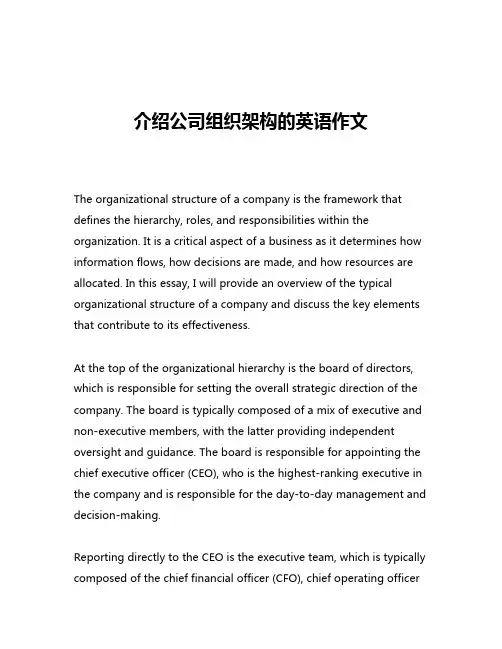
介绍公司组织架构的英语作文The organizational structure of a company is the framework that defines the hierarchy, roles, and responsibilities within the organization. It is a critical aspect of a business as it determines how information flows, how decisions are made, and how resources are allocated. In this essay, I will provide an overview of the typical organizational structure of a company and discuss the key elements that contribute to its effectiveness.At the top of the organizational hierarchy is the board of directors, which is responsible for setting the overall strategic direction of the company. The board is typically composed of a mix of executive and non-executive members, with the latter providing independent oversight and guidance. The board is responsible for appointing the chief executive officer (CEO), who is the highest-ranking executive in the company and is responsible for the day-to-day management and decision-making.Reporting directly to the CEO is the executive team, which is typically composed of the chief financial officer (CFO), chief operating officer(COO), and other senior-level executives. The executive team is responsible for developing and implementing the company's strategic plan, as well as overseeing the various functional areas of the business.The functional areas of a company are typically organized into departments or divisions, each with a specific area of responsibility. Common functional areas include finance, human resources, marketing, sales, operations, and information technology. Each department is typically led by a department head or director, who is responsible for managing the activities and personnel within that particular area.Within each department, there may be further subdivisions or teams, each with its own set of responsibilities and reporting structures. For example, the marketing department may have separate teams for brand management, digital marketing, and event planning, each with its own manager or team lead.One of the key benefits of a well-designed organizational structure is the clear delineation of roles and responsibilities. This helps to ensure that everyone in the organization understands their specific duties and accountabilities, which can improve efficiency, productivity, and decision-making. It also helps to prevent duplication of effort and confusion around who is responsible forwhat.Another important aspect of organizational structure is the communication and information flow within the company. A well-designed structure should facilitate the efficient and effective sharing of information, both vertically (between different levels of the hierarchy) and horizontally (across different departments or teams). This can help to ensure that everyone in the organization has access to the information they need to do their jobs effectively.The organizational structure of a company can also have a significant impact on its culture and employee engagement. A hierarchical, top-down structure can sometimes be perceived as rigid and bureaucratic, which can negatively impact employee morale and motivation. On the other hand, a more decentralized, collaborative structure can foster a sense of ownership and empowerment among employees, which can lead to higher levels of engagement and job satisfaction.In recent years, many companies have been experimenting with more flexible and agile organizational structures, such as the use of cross-functional teams or the adoption of a matrix structure. These approaches are designed to promote greater collaboration, innovation, and responsiveness to changing market conditions.Ultimately, the organizational structure of a company should be tailored to the specific needs and goals of the business. It should be designed to support the company's strategic objectives, optimize the use of its resources, and enable effective decision-making and communication. By getting the organizational structure right, companies can position themselves for long-term success and growth.。
机构组成翻译英语作文
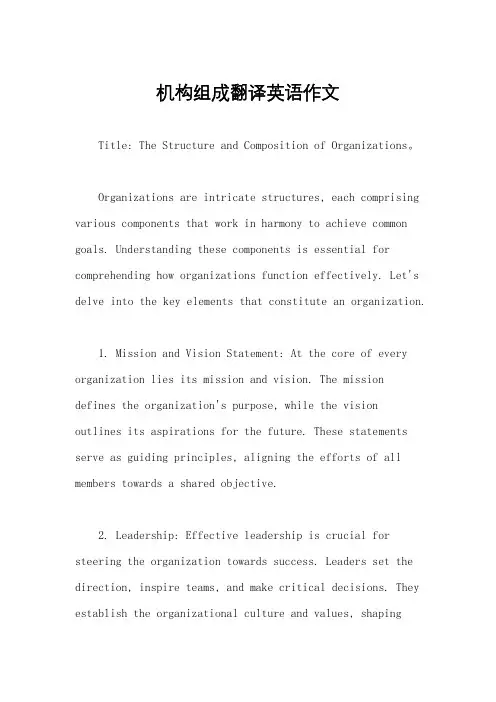
机构组成翻译英语作文Title: The Structure and Composition of Organizations。
Organizations are intricate structures, each comprising various components that work in harmony to achieve common goals. Understanding these components is essential for comprehending how organizations function effectively. Let's delve into the key elements that constitute an organization.1. Mission and Vision Statement: At the core of every organization lies its mission and vision. The mission defines the organization's purpose, while the visionoutlines its aspirations for the future. These statements serve as guiding principles, aligning the efforts of all members towards a shared objective.2. Leadership: Effective leadership is crucial for steering the organization towards success. Leaders set the direction, inspire teams, and make critical decisions. They establish the organizational culture and values, shapingthe behavior and mindset of its members.3. Departments and Divisions: Organizations typically consist of various departments or divisions, each responsible for specific functions or tasks. Common departments include finance, human resources, marketing, operations, and research and development. Dividing tasks among departments enhances efficiency and specialization.4. Employees: The workforce forms the backbone of any organization. Employees bring diverse skills, knowledge, and perspectives to the table, driving innovation and productivity. Hiring the right talent, nurturing their growth, and fostering a positive work environment are essential for organizational success.5. Communication Channels: Clear and effective communication is vital for seamless operations within an organization. Communication channels can range from formal (such as memos and meetings) to informal (such as water-cooler conversations). Ensuring open lines of communication facilitates collaboration and problem-solving.6. Organizational Culture: Culture encompasses the shared values, beliefs, and norms that define an organization. It influences how employees interact, make decisions, and perceive their work environment. A strong organizational culture fosters cohesion, loyalty, and employee satisfaction.7. Policies and Procedures: Organizations establish policies and procedures to govern various aspects of operations, from employee conduct to financial management. These guidelines ensure consistency, compliance with regulations, and mitigate risks.8. Resources: Organizations require various resources to function effectively, including financial, human, technological, and physical resources. Allocating resources efficiently and strategically is essential for optimizing performance and achieving objectives.9. Stakeholders: Stakeholders are individuals or entities with an interest or influence in theorganization's activities and outcomes. They can include employees, customers, suppliers, shareholders, government agencies, and the community at large. Engaging with stakeholders and addressing their needs builds trust and fosters long-term relationships.10. External Environment: Organizations operate withina broader external environment shaped by factors such as economic conditions, technological advancements, market trends, regulatory changes, and competitive pressures. Adapting to external forces and anticipating future trends is crucial for sustainability and growth.In conclusion, organizations are complex entities comprised of various interdependent components. By understanding and effectively managing these components, organizations can navigate challenges, capitalize on opportunities, and achieve their objectives in a dynamic and ever-changing world.。
组织结构英文作文模板
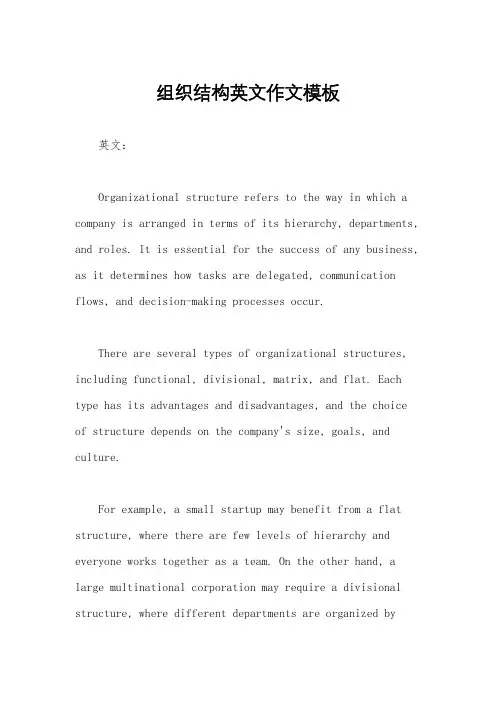
组织结构英文作文模板英文:Organizational structure refers to the way in which a company is arranged in terms of its hierarchy, departments, and roles. It is essential for the success of any business, as it determines how tasks are delegated, communication flows, and decision-making processes occur.There are several types of organizational structures, including functional, divisional, matrix, and flat. Each type has its advantages and disadvantages, and the choice of structure depends on the company's size, goals, and culture.For example, a small startup may benefit from a flat structure, where there are few levels of hierarchy and everyone works together as a team. On the other hand, a large multinational corporation may require a divisional structure, where different departments are organized byproduct, geography, or customer.The organizational structure also affects the company's culture and the way employees interact with each other. A hierarchical structure may create a more formal and rigid culture, while a flat structure may foster a more collaborative and innovative culture.Overall, the organizational structure plays a crucial role in the success of a company, and it is important for leaders to carefully consider and design the structure that best fits their organization.中文:组织结构是指公司在层级、部门和角色方面的排列方式。
组织结构运行Organization-Structure-Operation
组织结构运行Organization Structure Operation组织结构的运行Organization Structure Operation是组织结构“动态dynamic state”的一面,它是相对而言于“静态static state”而言的。
设计出的组织结构,仅仅是一个“框架framework”,尚处于“静态”之中。
为使组织结构在实现目标的过程中作出贡献,必须使它运行起来。
使组织结构运行起来的前提是配备人员,即按照组织结构中职位的要求配备相应的人员。
在其运行过程须不断地实施指导、领导和控制工作,同时还必须进行组织分析,以使组织结构运行有效。
在组织结构运行过程中,要正确处理的关系有:集权与分权、直线职权、参谋职权和职能职权、个人管理和集体管理等。
集权与分权Centralization & decentralization职权在组织的不同管理层次上如何分配,这是组织工作中一个非常重要的问题。
集权Centralization意味着职权集中到较高的管理层次,分权decentralization则表示职权分散到整个组织中。
集权与分权Centralization and decentralization是一个相对的概念,不存在绝对的集权和分权。
为使组织结构有效地运转,必须建立有层次的组织结构,同时必须确定好分权的程度,并做好授权。
1.集权制(System of centralization)System of centralization管理权较多地集中组织高层,其特点有:1)经营决策权大多集中在高层,基层只有日常的业务决策权2)对下级的控制多3)统一经营、统一核算2.分权制(System of decentralization):System of decentralization就是把管理权适当地分散在组织的中下层。
其特点是:1)中下层有较多的决策权2)上级的控制较少,往往以完成规定的目标为限3)在统一规划下可独立经营4)实现独立核算,但有一定的财务支配权3.影响集权或分权程度的因素1)决策的代价2)政策的一致性要求3)规模4)组织的形成历史5)管理哲学6)主管人员的数量和管理水平7)控制技术和手段的完善程度8)分散化的绩效9)组织的动态特性和职权的稳定性10)环境的影响组织结构的权力优化正确处理“直线职权、参谋职权和职能职权”的关系应注意:1.三种人员在管理工作中的相互关系在本质上是一种职权关系;2.注意发挥参谋人员的作用;3.发挥参谋作用应该注意的事项;1)参谋独立地提出建议2)直线不为参谋所左右4.适当地限制职能职权的使用;1)限制使用的范围:职能职权常限于解决“如何做How?何时做When”等问题;如果无限扩大到“在哪儿做Where”,“谁来做Who”,“做什么What”等方面的问题,就会取消直线人员的工作。
组织结构英文作文
组织结构英文作文英文:Organizational structure is an important aspect of any business or company. It refers to the way in which the company is organized and how tasks, roles, and responsibilities are distributed among its employees. There are various types of organizational structures, each with its own advantages and disadvantages.One common type of organizational structure is the hierarchical structure, where there is a clear chain of command and authority flows from the top down. In this type of structure, employees are organized into departments and each department is headed by a manager who reports to a higher-level manager. This structure is often used in large corporations and government agencies.Another type of organizational structure is the flat structure, where there are few levels of management andemployees have more autonomy and decision-making power. This structure is often used in startups and small businesses where the focus is on innovation and creativity.Finally, there is the matrix structure, which combines elements of both the hierarchical and flat structures. In this structure, employees are organized into teams that work on specific projects or tasks, and each team is headed by a project manager. This structure is often used in industries such as engineering and software development.中文:组织结构是任何企业或公司的重要方面。
企业组织英文范文
企业组织英文范文Title: Corporate Organizational Structure and Its Impact on Business PerformanceIntroductionCorporate organizational structure represents the way in which a company arranges its lines of authority, communication, and responsibilities. It plays a crucial role in shaping the overall functioning and performance of the business. This paper aims to explore the different types of organizational structures, their impact on business performance, and best practices for designing an effective organizational structure.Types of Organizational Structures1. Functional Structure: In this type of organization, employees are grouped based on their function or expertise, such as marketing, finance, operations, etc. It allows forspecialization and coordination within each department. However, it can lead to communication barriers between different functions.2. Divisional Structure: Companies using this structure group employees based on product lines, geographic locations, or customer segments. Each division operates as a separate entity with its own functional departments. This structure promotes flexibility and focus but can lead to duplicate functions across divisions.3. Matrix Structure: This structure combines both functional and divisional aspects, creating dual lines of authority. Employees report to both a functional manager and a product or project manager. It allows for more efficient resource utilization but can lead to power struggles and conflicting priorities.4. Team-based Structure: In this type of organization, employees are organized into project teams that areresponsible for specific tasks. It promotes collaboration, innovation, and adaptability but can lead to unclearreporting relationships and role ambiguity.Impact of Organizational Structure on Business Performance1. Communication: A well-designed organizationalstructure facilitates clear and effective communication. Aflat structure with fewer hierarchical levels can improve information flow and decision-making speed. On the other hand, a tall structure with multiple layers can slow down communication and create bottlenecks.2. Decision-making: The organizational structure significantly influences the decision-making process. Centralized structures concentrate decision-making power atthe top, leading to quicker decisions but limited input from lower-level employees. Decentralized structures pushdecision-making authority to lower levels, fosteringinnovation and employee empowerment but can lead to inconsistent decisions across the organization.3. Employee Morale and Motivation: The organizational structure shapes the work environment and can impact employee morale and motivation. Clear reporting relationships, role clarity, and opportunities for career advancement can boost employee satisfaction. In contrast, ambiguity, bureaucracy, and limited growth prospects can lead to dissatisfaction and turnover.Best Practices for Designing an Effective Organizational Structure1. Align with Business Strategy: The organizational structure should support the company's strategic goals and competitive positioning. For example, a company pursuing cost leadership may benefit from a functional structure that promotes efficiency and standardization.2. Flexibility and Adaptability: In today's dynamic business environment, organizations must be able to adapt quickly to changes in the market. A flexible structure that allows for innovation, collaboration, and cross-functional communication is essential for success.3. Clear Communication and Decision-making Processes: Employees should understand their role within the organization and have access to the information needed to perform their duties effectively. Decision-making processes should be transparent and aligned with the company's values and goals.4. Consideration of Company Size and Lifecycle: Small startups may benefit from a flat, informal structure that promotes creativity and agility. As the company grows, a more formalized structure with defined roles and responsibilities may become necessary.ConclusionIn conclusion, the organizational structure has a significant impact on a company's performance and success. By considering the various types of organizational structures, their impact on business performance, and best practices for design, companies can create a structure that supports their strategic objectives, fosters communication and collaboration, and promotes employee satisfaction and motivation.。
组织结构英文作文素材
组织结构英文作文素材英文回答:Organizational structure is the way in which an organization arranges its employees and resources to achieve its goals. It defines the roles, responsibilities, and lines of authority within the organization. There are many different types of organizational structures, each with its own advantages and disadvantages.One common type of organizational structure is the hierarchical structure. In a hierarchical structure, there is a clear chain of command, with employees reporting to managers, who in turn report to senior managers, and so on. This type of structure is often used in large organizations with a complex division of labor.Another common type of organizational structure is the flat structure. In a flat structure, there are few levels of management and employees have more autonomy. This typeof structure is often used in small organizations or in organizations that value creativity and innovation.The choice of organizational structure depends on a number of factors, including the size of the organization, the nature of its work, and its culture. There is no one-size-fits-all approach to organizational structure, and the best structure for one organization may not be the best for another.中文回答:组织结构是指组织安排员工和资源以实现其目标的方式。
- 1、下载文档前请自行甄别文档内容的完整性,平台不提供额外的编辑、内容补充、找答案等附加服务。
- 2、"仅部分预览"的文档,不可在线预览部分如存在完整性等问题,可反馈申请退款(可完整预览的文档不适用该条件!)。
- 3、如文档侵犯您的权益,请联系客服反馈,我们会尽快为您处理(人工客服工作时间:9:00-18:30)。
IntroductionNow human society has come into the 21 century. Organization and business has changed a lot compared with thirty years ago. As the development of organization structure, organizations have to adjust and change their structure modes in order to suit to new social environment. In traditional management theory, mechanistic structure and organic structure are the two kinds of organizational structure and are widely applied by most of organizations. Whether these two kinds of organizational structures are relevant to 21st century organizations is a very important topic for most organizational management. The aim of this essay is to state organic structure is more relevant to 21st century organizations. For the structure, it will firstly have an introduction and comparison of the features of mechanistic and organic structure. Secondly it will discuss why organic structure is more relevant to 21st century organizations compared with mechanistic structure.DiscussionNow it comes to have an introduction and comparison of features of organic structure and mechanistic structure. First is organic organization. Organic organization is also called as adaptive organization. Organic organization mainly has two features. Organic-type organization is a loose, flexible and hig hly adaptive form. It doesn’t have a standardized work and the rules and regulations, and it can quickly make adjustments as needed. (Litwin, S. 2002) The mainly features are low-standardization and low-centralization. Second is mechanistic structure. Mechanical organization is a stable, rigid structure; its main objective is the pursuit of efficiency and stable operation. It pursues to stabilize the operation efficiency and focus on the tasks and functions of a high degree of division of labor division. Reverse to organic structure, it has high-standardization and high-centralization. It is often adopted by bureaucracy organizations.For comparison of their features, the following diagram shows the differences between organic structure and mechanic structure.(Westbrook, J 2004)According to the above comparison of the features between mechanic structures and organic, now it aims to discuss why organic structure is more relevant to 21st organizations. This should base on the features of the 21st organizations’ developingtrend. This mainly includes three aspects.First, the 21st century situation needs organizations to have quick respond. As information technology develops better and better, business and operations become more and more complex, and there are often many uncertainties and emergency events. The IT time needs organizations can make quick respond for changes. For an organic structure organization, it has the features of low-standardization and low- centralization. When facing with emergency or unexpected changes, staffs can have their own decision—making right to deal with affairs timely. It is very important to avoid losses and mistakes in task. Also staffs can communicate with others to get the ideas for dealing with affairs. (Anders, C 2008) While for a mechanistic structure organization, when staffs face with changes or emergency, they don’t have decision making right. They must report it to their supervisors, and supervisors need to report to senior leaders. After the seniors make decision make give instruction to supervisors, supervisors can give instruction to staffs. The complex process will delay a lot of time and largely affect task efficiency. (Klarbring, A 2009) The organization cannot make quick respond to affairs and will lead to loss and troubles.Second, in 21st century, knowledge sharing and member communication become more and more important. As knowledge and experience improves very fast in 21st century, a single person or several persons cannot have the ability to acquire all necessary knowledge and technology in job process. And technology is the key factor for competitiveness. So the communication and knowledge sharing in organizations play very important roles for 21st century organizations. For an organic organization, staffs can well communicate with others, including supervisors and other staffs to become more familiar with necessary knowledge, which is very helpful for finishing tasks. Also it can improve the professional quality of all staffs. (Harrison, M and Janice, M. 2004) While for a mechanistic structure, the communication mode is vertical, and staffs can only receive orders from their supervisors. However, the supervisors all not all—round, if they don’t have enough knowledge acquirement, it will lead to troublesin task.Third, for 21st organizations, continuous creativity is the key factor to keep competitiveness. With economic globalization and information technology, user needs increasingly diversified and personalized, product technology content and research costs increased product and life cycles shorten. For this condition, organizations must keep creativity to keep their competitiveness in market economy and knowledge economy time. For an organic structure organization, its value is efficiency and performance. It emphasizes personal contribution and performance, and it encourages communications among all people. This supplies good environment for creativity. Also its low-centralization helps staffs to perform innovation tasks without constraint. (Kenny, G 2006) Staffs can try their best to make develop creativity and make performance. However, for a mechanistic structure organization, the value is to obey rules and supervisors. Staffs don’t have the motivation and right to share knowledge and make creativity. Only the senior leaders can make creativity and make decision. This largely hinders creativity in organizations.ConclusionIn conclusion, for 21st organizations, they need to have quick respond, good knowledge sharing and member communication and continuous creativity to keep their competitiveness and according to structure features, organic structure is more relevant to 21st organizations. After the above discussion, it is found that the low- standardization and low-centralization and the value of staffs’ performance are helpful for an organic organization to make quick respond to emergency, form a good environment for knowledge sharing and communication and encourage creativity, while the high-standardization and high-centralization and the value of obeying rules and supervisors seriously hinder a mechanistic structure organization in the three aspects. So according to above discussion, it proves that organic structure is more relevant to 21st organizations.。
